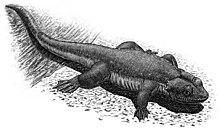Monjurosuchus
| Monjurosuchus Temporal range: Early Cretaceous
| |
|---|---|

| |
| Fossil specimen, on display at the National Museum of Natural Science | |
| Scientific classification | |
| Domain: | Eukaryota |
| Kingdom: | Animalia |
| Phylum: | Chordata |
| Class: | Reptilia |
| Order: | †Choristodera |
| Genus: | †Monjurosuchus Endo, 1940 |
| Species | |
| |
Monjurosuchus is a
. It has large eyes, a rounded skull, robust legs with short claws, and a long, thin tail. Fossils have been found that preserve soft tissue, showing that it had soft skin and webbed feet.Description and history

Monjurosuchus was first found in China as part of the Early Cretaceous
Monjurosuchus was a small choristodere, reaching a total body length of 30–40 cm (0.98–1.31 ft).

Specimens from China preserve soft tissue, including scales and webbing between the toes of the feet. The scales of Monjurosuchus were small, giving the animal soft skin. Two rows of larger scutes run along its back. The rest of the scales on the back are small, while the scales on the underside are slightly smaller. The skin of Monjurosuchus has a similar appearance to the living Chinese crocodile lizard Shinisaurus.[1]
The feet of Monjurosuchus are webbed, with skin covering all parts of the foot but the short claws. The limbs were robust and the hips are wide. The long, slender tail shows no adaptations for its presumed semi-aquatic lifestyle.
Classification
Monjurosuchus is a
Phylogeny from the analysis of Dong and colleagues (2020):[5]
| Choristodera |
| ||||||||||||||||||||||||||||||||||||||||||||||||||||||||||||||||||||||||||||||||||||||||||||||||
References
- ^ S2CID 86064702.
- ^ a b Matsumoto, R.; Evans, S.E.; Manabe, M. (2007). "The choristoderan reptile Monjurosuchus from the Early Cretaceous of Japan" (PDF). Acta Palaeontologica Polonica. 52 (2): 329–350.
- ^ Dudgeon, Thomas William (2019). The internal cranial anatomy of Champsosaurus lindoei and its functional implications (PDF). Earth Sciences (M.Sci.). Ottawa, Ontario: Carleton University.
- .
- S2CID 219047160.
